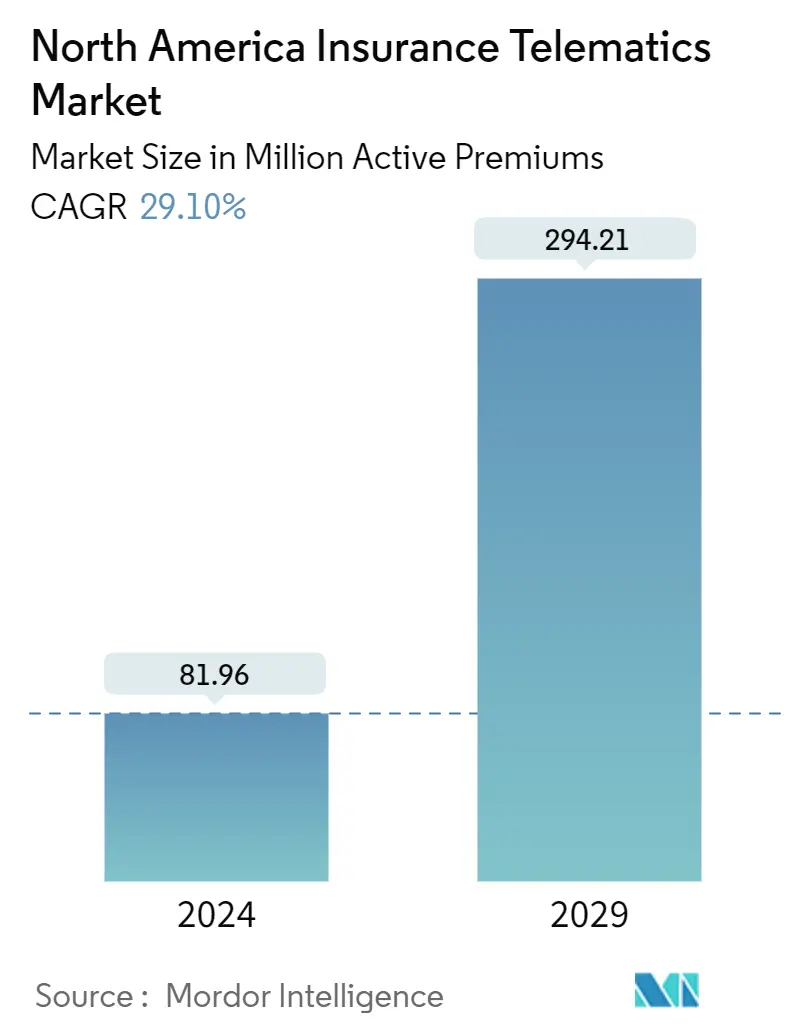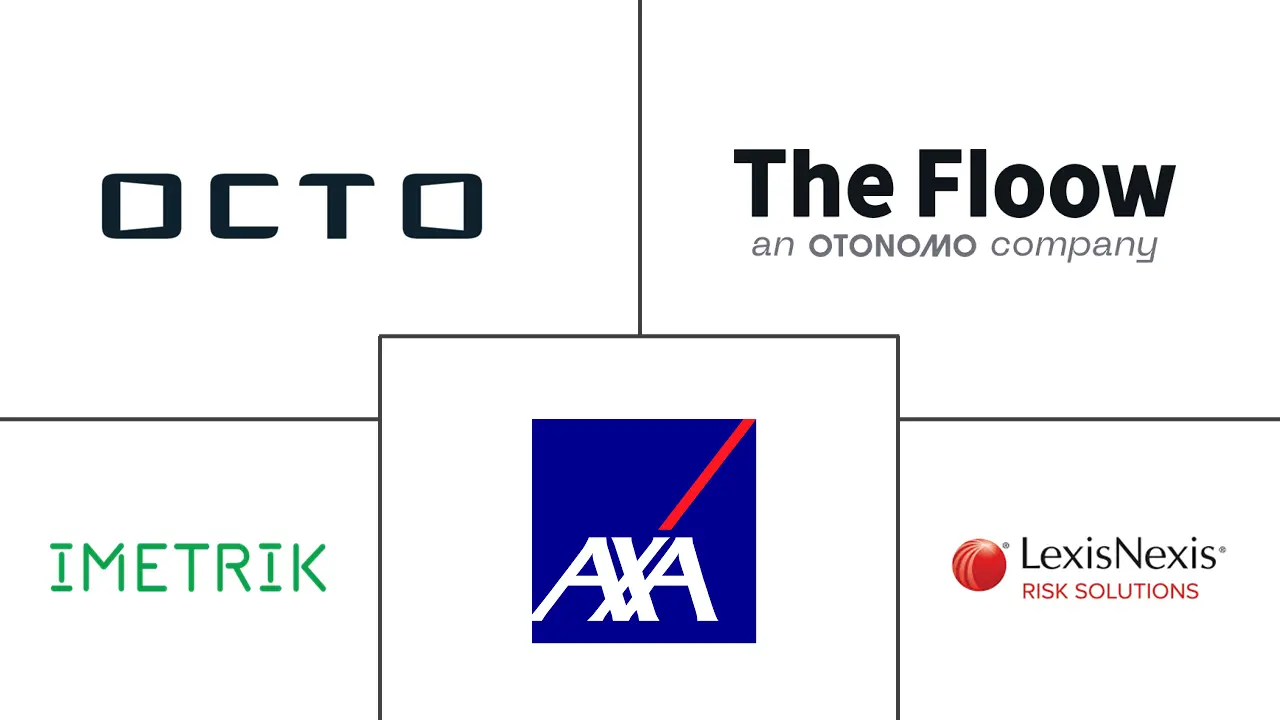Market Size of North America Insurance Telematics Industry

| Study Period | 2019 - 2029 |
| Base Year For Estimation | 2023 |
| Market Volume (2024) | 81.96 Million active premiums |
| Market Volume (2029) | 294.21 Million active premiums |
| CAGR (2024 - 2029) | 29.10 % |
| Market Concentration | Low |
Major Players
*Disclaimer: Major Players sorted in no particular order |
North America Insurance Telematics Market Analysis
The North America Insurance Telematics Market size is estimated at 81.96 Million active premiums in 2024, and is expected to reach 294.21 Million active premiums by 2029, growing at a CAGR of 29.10% during the forecast period (2024-2029).
The growing demand for telematic devices among the insurance and automotive sectors propels the market's growth. Many automotive companies invest in advanced telematics systems to gain a competitive edge. From application-specific telematics and computer imaging, fleet managers can access a wealth of information about the condition of their vehicles.
- Rising congestion and road traffic have made people's safety a top priority. Improving advanced vehicle features is a significant factor aiding the growth of the demand for vehicle insurance telematics. According to the National Safety Council, some 47,000 road traffic fatalities occurred in the United States in 2021, which was the most significant number of deaths recorded in the country since 2012. This fatality volume was slightly dipped in 2022, down to nearly 46,300. Motor vehicle crashes are a frequent cause of death in the United States.
- In addition, according to the official source, in 2023, there were 6,102,936 police-reported vehicle accidents in the United States. Of those, 39,508 were fatal. Such increases in road accidents may further create demand for insurance telematics in the region.
- Various governments are taking initiatives in road safety to avoid accidents or car crashes, which may create demand for insurance telematics in the region. Furthermore, Canada's fourth national road safety plan, the Road Safety Strategy (RSS) 2025, was launched by the Council of Ministers Responsible for Transportation and Highway Safety in early 2016. The goal remains to achieve downward trends in fatalities and severe injuries throughout a five-year duration, comparing multi-year rolling averages with the established baseline period.
- However, a lack of awareness of insurance telematics and privacy and security concerns somewhat hinder the market. On the other hand, increasing innovation in the automotive enterprise and untapped potential in emerging economies present new opportunities in the upcoming years.
- The COVID-19 pandemic had a positive impact on the insurance telematics industry. This is attributed to telematics directly addressing consumer needs to pay lower premiums when the vehicles had limited utilization during the lockdown.
- In addition, the pandemic changed insurers' demands from traditional actuarial and underwriting models to pay-as-you-drive (PAYD) models. In addition, increased acceptance of digital tools in the policy binding and claims process among consumers, combined with a need for insurers to design premium policies more precisely, are significant factors that notably contribute to the market's growth.
North America Insurance Telematics Industry Segmentation
Insurance telematics is used to track how people drive. It involves technology, such as GPS and sensors, to monitor and collect data on an individual's driving behavior. Insurance organizations use this data to assess risk and set personalized premiums accurately. Telematics devices installed in a vehicle help to track various parameters, such as speed, distance, and driving habits, which allows insurers to reward safe driving or adjust premiums based on actual usage patterns. Various telematics devices include cigarette-lighter plugs, smart tags, OBD (On-Board Diagnostic) devices, battery lines, windshield-mounted devices, black boxes, and smartphone apps.
The market for insurance telematics was analyzed considering the total number of active premiums filed by the various insurance providers across North America. The scope of the study includes different usage-based insurance telematics revenue models that are pay-as-you-drive, pay-how-you-drive, and manage-how-you-drive. The study also compares various types of telematics hardware insurance solutions across the United States and Canada, such as portable, embedded, and smartphone-based. The study also tracks the key market parameters, underlying growth influencers, and major vendors operating in the industry, which supports the market estimations and growth rates during the forecast period. The study further analyzes the overall impact of COVID-19 and macroeconomic trends on the ecosystem. The report's scope encompasses market sizing and forecasts for the various market segments.
The North American insurance telematics market is segmented by country (United States, Canada). The market size and forecasts regarding the number of active premiums for all the above segments are provided.
| By Country | |
| United States | |
| Canada |
North America Insurance Telematics Market Size Summary
The North American insurance telematics market is experiencing significant growth, driven by the increasing demand for telematic devices within the insurance and automotive sectors. This growth is fueled by advancements in connected car technologies, such as embedded telematics systems and onboard sensors, which provide insurers with real-time data on vehicle performance and driver behavior. The rise in road traffic and accidents has heightened the focus on vehicle safety, further propelling the demand for insurance telematics. Governments are also promoting road safety initiatives, which contribute to the market's expansion. Despite challenges like privacy concerns and a lack of awareness, the market is poised for growth, supported by innovations in the automotive industry and the shift towards pay-as-you-drive models.
The market landscape is characterized by a fragmented competitive environment, with key players like Octo Telematics SpA, IMERTIK Global Inc., and AXA SA actively engaging in partnerships and acquisitions to enhance their offerings. The COVID-19 pandemic has positively impacted the industry by accelerating the adoption of digital tools and usage-based insurance models. The United States is expected to be a significant market due to its substantial presence of automotive OEMs and the widespread adoption of 4G/5G technologies. As insurers leverage telematics data to offer personalized and data-driven insurance products, the market is set to benefit from the growing integration of autonomous and semi-autonomous vehicle technologies.
North America Insurance Telematics Market Size - Table of Contents
-
1. MARKET INSIGHTS
-
1.1 Market Overview
-
1.2 Industry Attractiveness - Porter's Five Forces Analysis
-
1.2.1 Bargaining Power of Suppliers
-
1.2.2 Bargaining Power of Buyers
-
1.2.3 Threat of New Entrants
-
1.2.4 Threat of Substitute Products
-
1.2.5 Degree of Competition
-
-
1.3 Industry Value Chain Analysis
-
1.4 Impact of COVID-19 Aftereffects and Other Macroeconomic Factors on the Market
-
-
2. MARKET SEGMENTATION
-
2.1 By Country
-
2.1.1 United States
-
2.1.2 Canada
-
-
North America Insurance Telematics Market Size FAQs
How big is the North America Insurance Telematics Market?
The North America Insurance Telematics Market size is expected to reach 81.96 million active premiums in 2024 and grow at a CAGR of 29.10% to reach 294.21 million active premiums by 2029.
What is the current North America Insurance Telematics Market size?
In 2024, the North America Insurance Telematics Market size is expected to reach 81.96 million active premiums.

